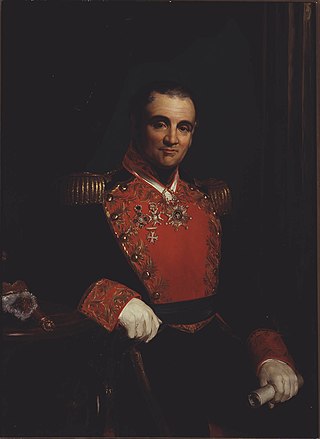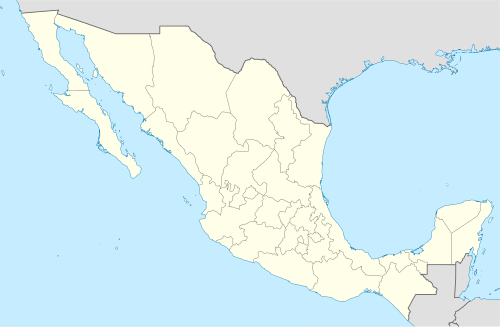
José Mariano Martín Buenaventura Ignacio Nepomuceno García de Arista Nuez was a Mexican soldier and politician who also became president of Mexico.

Guadalupe Victoria, born José Miguel Ramón Adaucto Fernández y Félix, was a Mexican general and politician who fought for independence against the Spanish Empire in the Mexican War of Independence and after the adoption of the Constitution of 1824, was elected as the first president of the United Mexican States. He was a deputy in the Mexican Chamber of Deputies for Durango and a member of the Supreme Executive Power following the downfall of the First Mexican Empire, which was followed by the 1824 Constitution and his presidency. He later served as Governor of Puebla.

Valentín Gómez Farías was a Mexican physician and liberal politician who became president of Mexico twice, first from 1833 to 1834, during the period of the First Mexican Republic, and again from 1846 to 1847, during the Mexican–American War.

José Mariano Salas Barbosa was a Mexican soldier and politician who served twice as interim president of Mexico, once in 1846, during the Mexican American War, and once in 1859 during the War of Reform.

Valentín Canalizo Bocadillo, was a Mexican general and statesman who served twice as interim president during the Centralist Republic of Mexico and was later made Minister of War during the Mexican American War.

José Ventura Melchor Ciriaco de Ecay-Múzquiz y Arrieta was a Mexican soldier and politician who became the 5th President of Mexico after president Anastasio Bustamante stepped down to personally lead his armies against an 1832 insurgency known as the Plan of Veracruz.

Miguel Francisco Barragán Andrade was a Mexican soldier and politician who served as interim president of Mexico in 1836. He had previously served as Governor of Veracruz, and gained national fame for the capture of the Fortress of San Juan de Ulúa in 1824, through which Spanish military presence was finally expelled from Mexico.

Manuel Gómez Pedraza y Rodríguez was a Mexican general who also became president of Mexico during the First Mexican Republic.

Trinidad Anastasio de Sales Ruiz Bustamante y Oseguera was a Mexican physician, general, and politician who served as the 4th President of Mexico three times from 1830 to 1832, 1837 to 1839, and 1839 to 1841. He also served as the 2nd Vice President of Mexico from 1829 to 1832 under Presidents Vicente Guerrero, José María Bocanegra, himself, and Melchor Múzquiz. He participated in the Mexican War of Independence initially as a royalist before siding with Agustín de Iturbide and supporting the Plan of Iguala.

Gabriel Valencia was a Mexican soldier in the early years of the Republic. From December 30, 1845 to January 2, 1846 he served as interim president of Mexico. He was the President of the Chamber of Deputies in 1843.

The following is an alphabetical index topics related to Mexico.

Antonio de Padua María Severino López de Santa Anna y Pérez de Lebrón, usually known as Antonio López de Santa Anna, or just Santa Anna, was a Mexican soldier, politician, and caudillo who served as the 8th president of Mexico multiple times between 1833 and 1855. He also served as Vice President of Mexico from 1837 to 1839. He was a controversial and pivotal figure in Mexican politics during the 19th century, to the point that he has been called an "uncrowned monarch", and historians often refer to the three decades after Mexican independence as the "Age of Santa Anna".

Spanish attempts to reconquer Mexico were efforts by the Spanish government to regain possession of its former colony of New Spain, resulting in episodes of war comprised in clashes between the newly born Mexican nation and Spain. The designation mainly covers two periods: the first attempts occurred from 1821 to 1825 and involved the defense of Mexico's territorial waters, while the second period had two stages, including the Mexican expansion plan to take the Spanish-held island of Cuba between 1826 and 1828 and the 1829 expedition of Spanish General Isidro Barradas, which landed on Mexican soil with the object of reconquering Mexican territory. Although the Spanish never regained control of the country, they damaged the fledgling Mexican economy.

The Centralist Republic of Mexico, or in the anglophone scholarship, the Central Republic, officially the Mexican Republic, was a unitary political regime established in Mexico on 23 October 1835, under a new constitution known as the Siete Leyes after conservatives repealed the federalist Constitution of 1824 and ended the First Mexican Republic. It would ultimately last until 1846, when the Constitution of 1824 was restored at the beginning of the Mexican–American War.
José Gabriel de Armijo (1774–1830) was a Spanish and Mexican military commander of caudillo origin known for his role in the Mexican War of Independence.
In the history of Mexico, the Plan of Cuernavaca was a declaration made in Cuernavaca on 25 May 1834 in opposition to reform measures by the liberal administration of Vice President Valentín Gómez Farías. Presumably the declaration was orchestrated by President Antonio López de Santa Anna in agreement with the high clergy. After the triumph of the Plan of Cuernavaca, all laws enacted by the progressives during ten months in office were repealed, the Pontifical and National University of Mexico was reopened, Congress was dissolved and the officials who implemented the reform measures were dismissed. Santa Anna's first dictatorship began. A year later, the conservative faction of the Congress approved the basis for the new constitution that gave rise to the centralist regime in Mexico.

Juan Cayetano José María Gómez de Portugal y Solís was a university professor and the Bishop of Michoacán. He played an active role in the politics of Mexico.
In the history of Mexico, the Plan of Veracruz was a call to revolt against Emperor of Mexico Augustín de Iturbide, proclaimed by Antonio Lopez de Santa Anna at the port of Mexico on December 2, 1822. It was ratified on December 6.
José María Alpuche e Infante was a Mexican priest, politician, public speaker and writer. During his performance in politics he radically defended federalism and was a member of the York Masonic lodge.
Francisco Fernández y Félix, better known as Francisco Victoria, was an insurgent of the Mexican War of Independence. Being a republican and federalist ideologue, he fought against the imperialist regime of Agustín de Iturbide and the centralist regime of Anastasio Bustamante.
















